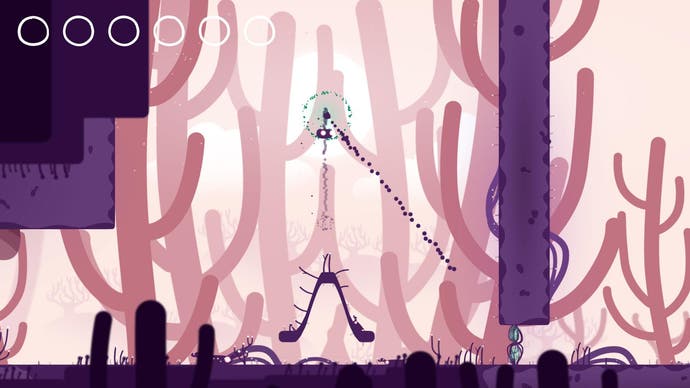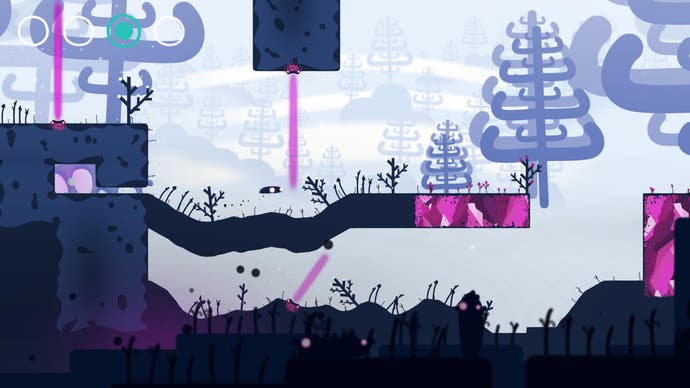Semblance review - a wibbly, wobbly platformer that turns the genre upside down
Play D'oh.
Before there were fidget spinners, there were stress balls. You remember them, right? Those squishy, malleable balls of goo that could be squeezed and pulled and manipulated in a myriad of eye-watering ways, ostensibly to help people channel their frustration and anger, but only ever really used to sedate restless hands for a day or two before being shoved, forgotten, into a desk drawer.
In Semblance you play as one of those squishy, malleable balls of goo that leaps and squeezes and wiggles, collecting orbs to reverse the thin layer of infectious crust that's creeping across your soft, moldable world. A press release calls it an "engaging, yet minimalist story" but I don't quite truck with that, because I didn't even realise there was a story, not until I'd finished the game and sat down to write this review.
That's not a criticism, though; at its heart Semblance is a puzzle game, and while we all know how important - how effective - storytelling has become in contemporary gaming, it's never essential, not really, not if the bones of a game are strong enough to carry it without the meat of a narrative. To its credit, Semblance's bones are gorgeous.
Your goo ball is called Squish, but you won't know that from playing, either. That aforementioned press release says an infection is feeding off the playdough world to survive, and some omnipotent guardian created Squish so it could find and reclaim the essence of their world to bring it back to life. Semblance doesn't need this thin cloak of a story, really; the subtle allure of the puzzles and the clean, unassuming presentation hooked me before I even clocked the lack of story.
It's a puzzle-platformer that turns the genre entirely on its head. Rather than use the platforms to traverse the world and move onto the next level, your job is to actually use those platforms, reshaping and remodelling them to help you get around and collect orbs, the luminescent balls of light that help free the trees from the sharp, jagged crust of infection.
Each section primes you for the one ahead, the colours melting from one soft pastel shade to the next as you jump, dash, and wiggle your way forward. You'll quickly learn which surfaces are malleable and which are not (pro tip: solid sections are yours to manipulate; platforms speckled with colour are not), and how best to reshape the environment to get around.

At first, everything's pretty straightforward, albeit rarely easy, but Semblance is masterful in its ability to keep you thinking creatively. Is an orb too high to jump to? Well, headbutt the platform from beneath and you can make it taller. A gap too narrow to squeeze through? Slam Squish into a particular wall, and you'll flatten it into a disc. Is an enemy flitting back and fore, blocking your exit? Burrow downward to create divots in the ground.
But while many of your abilities can be unravelled by experimentation, not everything is well telegraphed, and it took me an astonishingly (and embarrassingly) long time to "accidentally" work out that some platforms can be shifted right or left. That said, the new mechanics come in at a trickle so they rarely overwhelm you, but sadly not all of the tools at Squish's disposal are equal, with some levels falling foul of frustrating physics, the control scheme, a lack of direction, and/or a tiresome combination of all those things.
The further into the world you go, the more complex the puzzles become. You'll encounter lasers and fatal shards of hard crystal that can take you out and reset your position, or light beams that can undo your careful modifications with an accidental tap. Sometimes you'll work out how to get an orb, but for the life of you (or Squish's, if we're being accurate), not how to get back safely again.
If you fail and "die" immediately after securing an orb, it's ruthlessly ripped away again, forcing you to replay it properly. It's a feature I simultaneously both love and loathe, as while it stops me cheesing the solution, it's teeth-grindingly frustrating to be reset when you've spent the last 20 minutes trying to get there in the first place.
Eventually you'll encounter places you can no longer reshape to your whim, so instead, you learn to reshape you, giving Squish's jumps additional height or breadth, but at the expense of other traits.

As you progress, however, the physics are just as wobbly as Squish. You're able to "reset" the features if you find yourself needing a do-over, but occasionally, doing so traps Squish in the environment. As the puzzles intensify your timings and finger work need to be that much more precise, and areas that had me jumping and dashing whilst instantaneously trying to avoid jagged spikes were the few times that Semblance frustrated more than it entertained. It's one thing not to know how to solve a puzzle; it's quite another to know how it's done, but simply lack the coordination to pull off such dexterity, especially if it's a big puzzle that's zoomed out on Nintendo Switch's six-inch screen and you're using Joy-Cons.
And the less said about the rushed, anticlimactic ending the better. Sadly, it's every bit as underwhelming as the story that gets you there.
For the most part, though? For the most part, Semblance was my stress ball. The gentle tinkle of its score, the way Squish's eyes dance around, the way the plants and onlookers jiggle a little as you pass by; individually they're lovely touches but united they create a hypnotic experience that's curiously relaxing. And while achingly short, clocking in at just half a dozen or so hours, it doesn't outstay its welcome thanks to the continual reinvention of its props and mechanics.
While not perfect, Semblance is perfectly lovely, and if you're looking for something small and undemanding to keep you company on your holiday or commute, you could do worse than spend a little quality time with our kid Squish.



